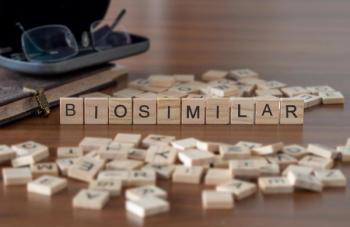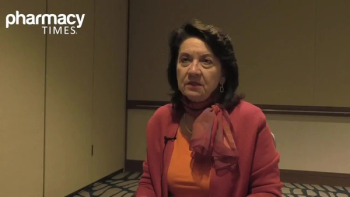
Dual-Targeted Therapy With Ruxolitinib and Duvelisib: Optimizing Treatment for T-Cell Lymphomas Through Pharmacist Collaboration
Alison Moskowitz, MD, discusses the clinical considerations, dosing strategies, and the critical role of pharmacists in managing toxicities and tailoring treatment plans for dual-targeted therapy with ruxolitinib and duvelisib.
Pharmacy Times® interviewed lead investigator Alison Moskowitz, MD, an associate attending and clinical director of the Lymphoma Service in the Department of Medicine at Memorial Sloan Kettering Cancer Center in New York, who presented research on dual-targeted therapy with ruxolitinib (Jakafi; Incyte Corporation) plus duvelisib (Copiktra; Secura Bio, Inc) for T cell lymphoma (TCL). In the interview, Moskowitz discussed the dosing and clinical considerations of combining ruxolitinib and duvelisib for the treatment of peripheral TCL (PTCL).
Moskowitz emphasized that patients most likely to benefit from this combination are those with T-follicular helper (TFH) lymphomas or T-cell prolymphocytic leukemia (T-PLL), as these histologies are often associated with JAK/STAT pathway activation. Ongoing study expansions aim to better define the efficacy of this approach within these subgroups.
Moskowitz noted in the interview that pharmacists play a critical role in treatment planning and patient counseling for this combination treatment. For patients with relapsed or refractory TFH lymphoma, the combination therapy may be used to achieve remission before proceeding to allogeneic stem cell transplant, with the best responses typically observed within one to two months of treatment. For transplant-ineligible patients, long-term use of the combination may be necessary, with dose modifications to ensure ongoing tolerability. Pharmacists can assist by monitoring for toxicities, guiding dose adjustments, and tailoring therapy plans based on patient-specific goals and histological subtypes. This approach ensures both the effectiveness and safety of treatment while aligning with individual patient needs.
Pharmacy Times: How does the maximum tolerated dose of ruxolitinib and duvelisib at 20 mg twice a day (BID) and 25 mg BID, respectively, compare to their use as monotherapies, and what implications might this have for managing toxicities in clinical practice?
Alison Moskowitz, MD: For PTCL, the optimal dose of single agent duvelisib is 75 mg BID for the first 2 cycles followed by 25 mg BID. For ruxolitinib, our phase 2 study evaluated 20 mg BID, which is the same dose we evaluated with duvelisib.
Two patients experienced dose-limiting toxicities while receiving duvelisib 25 mg BID combined with ruxolitinib 20 mg BID; therefore, we did not evaluate higher doses of duvelisib. The dose-limiting toxicities were grade 4 thrombocytopenia and grade 4 neutropenia. In addition, the most common toxicities we observed were hematologic in nature.
Although many patients on the study were able to remain on treatment for a prolonged period of time, about a third of patients required dose reductions for toxicity. When this combination is used in practice, it will be important to monitor blood counts weekly for the first month and then every 2 weeks thereafter to assess for the need for dose reductions.
Pharmacy Times: What strategies can pharmacists implement to monitor and mitigate the grade 3 and 4 adverse events observed with this combination therapy, such as neutropenia, thrombocytopenia, and transaminitis?
Moskowitz: Patients should have blood counts monitored weekly for the first month followed by every other week if stable. In addition, liver function tests will need to be monitored monthly or more often if there are abnormalities. Our protocol had specific guidelines for dose reductions, which we will include in a future publication.
Pharmacy Times: How can pharmacists contribute to identifying patients most likely to benefit from this dual-targeting approach, particularly those with TFH lymphomas or evidence of JAK/STAT pathway activation?
Moskowitz: The take home message from the study for now is that patients with TFH lymphomas and T-PLL are most likely to benefit from this combination. We are expanding the study to further evaluate efficacy within these 2 groups.
These histologies are potentially most responsive to this combination because they are often associated with JAK/STAT pathway activation. We will learn more through the expansion, but for now, it makes most sense to consider this combination for patients with TFH lymphoma or T-PLL rather than focus on JAK/STAT pathway activation.
Pharmacy Times: What should be considered when implementing herpes zoster and Pneumocystis pneumonia (PCP) prophylaxis for patients receiving this regimen?
Moskowitz: All patients require prophylaxis for herpes zoster and PCP. This was standard in our protocol.
Pharmacy Times: Based on differing overall response rates and complete response rates among histological subtypes, how can pharmacists assist in guiding treatment planning and patient counseling?
Moskowitz: The goal of therapy for individual patients will impact the duration of treatment with this combination. For patients with relapsed or refractory TFH lymphoma, allogeneic stem cell transplant could be potentially curative. The combination of ruxolitinib plus duvelisib may be used to get patients into remission before transplant. We typically observe the best response after only 1 to 2 months of treatment, and therefore we would not expect patients to remain on long-term treatment if they are proceeding to transplant. In contrast, patients who are ineligible for transplant would be expected to be on treatment for as long as it is effective and tolerable. For patients expected to be on long-term treatment, it may be necessary to consider dose modifications to ensure ongoing tolerability.
Newsletter
Stay informed on drug updates, treatment guidelines, and pharmacy practice trends—subscribe to Pharmacy Times for weekly clinical insights.


















































































































































































































